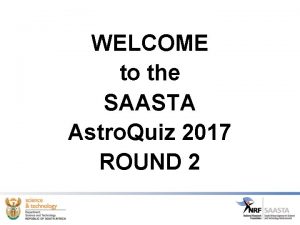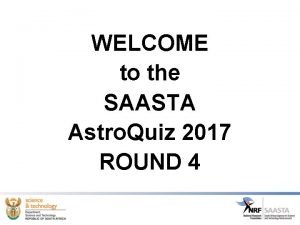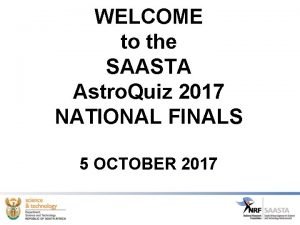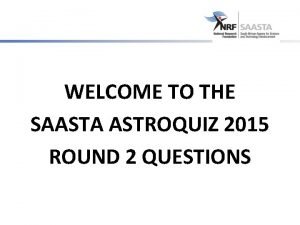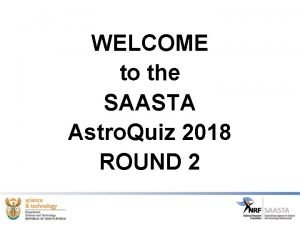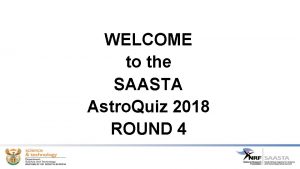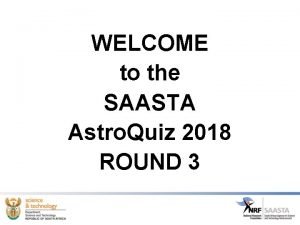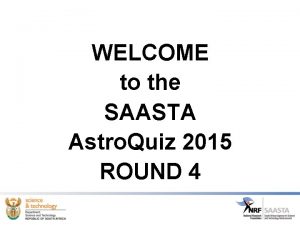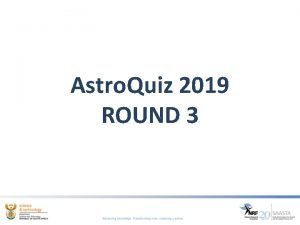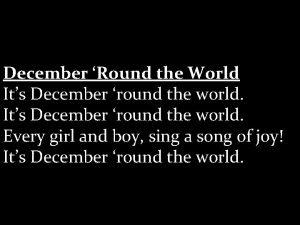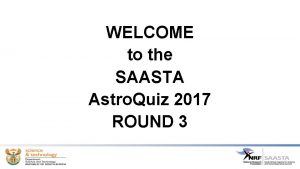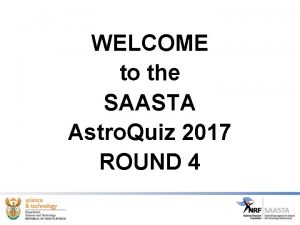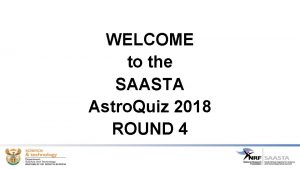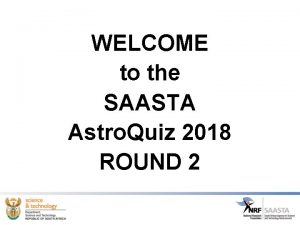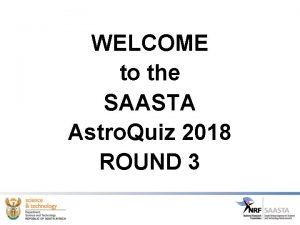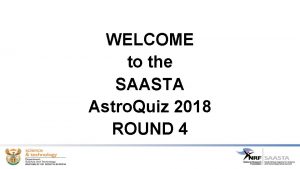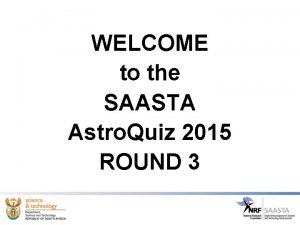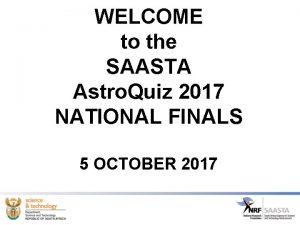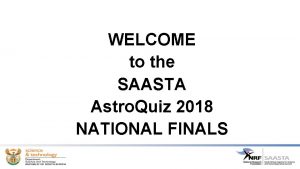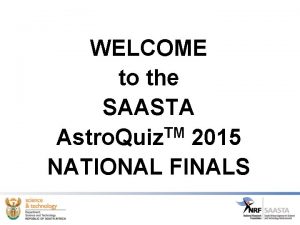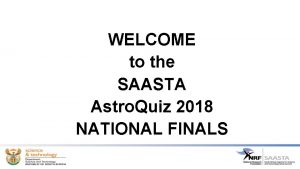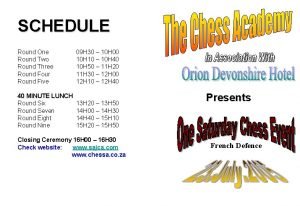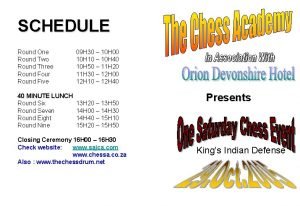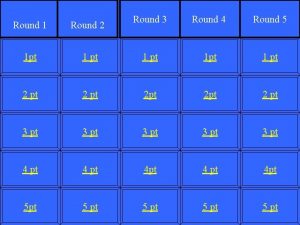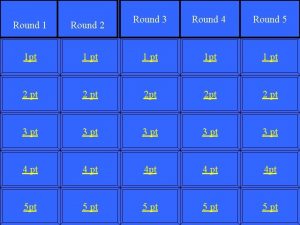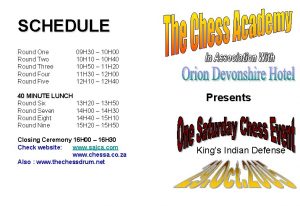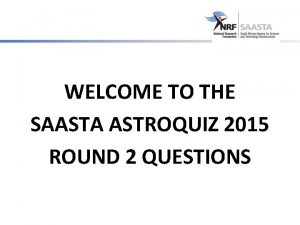WELCOME to the SAASTA Astro Quiz 2017 ROUND



































- Slides: 35

WELCOME to the SAASTA Astro. Quiz 2017 ROUND 4

RULES • You only have 60 seconds to answer the questions. • You are allowed to discuss amongst yourselves as team members. • Calculators may be used if needed. • No internet is to be used, therefore the use of cellphones is also prohibited. • The judge’s decision is final.

DIAGRAM 1: The next 6 questions refer to this image.

MORE INFORMATION • • Diameter of the Moon = 3 475 km Diameter of the Earth = 12 756 km Diameter of the Sun = 1 391 000 km Circumference of the Sun = 4 366 813 km Volume of the Sun is 1. 4 x 1027 m 3 Volume of the Earth = 1. 1 x 1021 m 3 Volume of the Moon = 2. 2 x 1019 m 3

QUESTION 1 This diagram shows ____ A. The entire solar system B. An eclipse C. A comet passing the Earth D. The daily relationship between the Earth, Moon and Sun

QUESTION 2 What type of eclipse does this diagram show? A. Lunar Eclipse B. Transit Eclipse C. Solar Eclipse D. Galaxy Eclipse

QUESTION 3 The sequence, C on Diagram 1, relates to the larger diagram. It shows _______ as seen from the Earth. A. A dark spot on the Sun B. The transition of the Moon across the Sun C. The phases of the Moon D. The phases of the Sun

QUESTION 4 The full shadow cast by the Moon onto the Earth in the diagram (A) is called____ A. The Shadow B. The Umbra C. The Penumbra D. The Full Point

QUESTION 5 The partial shadow cast by the Moon onto the Earth in the diagram (B) is called. A. The Secondary Shadow B. The Umbra C. The Penumbra D. The Partial Point

QUESTION 6 South Africa's Meer. KAT telescope is an SKA 'pathfinder' telescope. How many dish-shaped antennas will it consist of? A. B. C. D. 64 74 46 47

QUESTION 7 The third closest star to Earth after the Sun is at a distance of approximately 4, 37 light years. If 1 light year = 9, 46 x 1012 km, how far is it in kilometres? A. B. C. D. 2. 16 x 1012 4. 62 x 1010 5. 09 x 1012 4. 13 x 1013

QUESTION 8 If the Earth has a radius of 6378 kilometres, what will its circumference be in kilometres? NB: C = 2 π r , π = 3. 14 A. B. C. D. 4. 01 x 104 4. 001 x 105 4. 001 x 106 40. 1 x 107

QUESTION 9 The brightest star in the sky, Sirius, is/was __ A. B. C. D. closest to the Earth whiter and hotter than the Sun blue and hot discovered by Robert Innes in 1915

QUESTION 10 During total lunar eclipse ______ A. The Sun is behind Earth, so the Sun's light casts Earth's shadow on the Moon. B. Moon is between the Earth & the Sun C. The Sun is between the Earth & Moon D. The Earth is behind the Sun so that sunlight hits the Moon directly

QUESTION 11 What is a loose collection of ice, dust and small rocky particles, typically with a long, narrow orbit called? A. B. C. D. Comet Asteroid Meteorite

QUESTION 12 What gives Mars its reddish colour? A. Sunlight B. Iron Oxide C. Glass D. Water

QUESTION 13 Who developed the three laws describing the motion of planets? A. Tycho Brahe B. Albert Einstein C. Johannes Kepler D. Daniel Young

QUESTION 14 Albert Einstein is most famous for his theory of __ A. Relationships B. Archaeology C. Philosophy D. Relativity

QUESTION 15 For a solar eclipse to occur, ____ A. the Sun must be directly between Earth and the Moon B. the Moon must be directly between Earth and the Sun C. the Moon must be directly behind Earth D. Earth must be directly between the Sun and the Moon

QUESTION 16 In 1993, the European communications satellite Olympus was hit by a ____ and the mission had to be cancelled. A. Meteor B. Meteorite C. Meteoroid D. Constellation

QUESTION 17 Jupiter's Great Red Spot is a giant ___ A. Storm B. Crater C. Ocean D. Volcano

QUESTION 18 What do we call the part of the Sun that is most easily seen during a total solar eclipse? A. Solar wind B. Heliosphere C. Corona D. Hemisphere

QUESTION 19 Where do we find most asteroids in our solar system? A. Between Mars and Earth B. Between Mars and Jupiter C. Between Mars and Saturn D. Between Mars and Pluto

QUESTION 20 Which type of telescope never has problems seeing through Earth's atmosphere and can use mirrors or lenses to enlarge an object. A. Earth-based telescope B. Reflecting telescope C. Refracting telescope D. Space-based telescope

QUESTION 21 The brightest star in the night sky is Sirius. What is the name of the second brightest star? A. Arcturus B. Canopus C. Rigel D. Betelgeuse

QUESTION 22 The Southern Cross, Crux, is the smallest constellation whilst ____ is the largest in the sky. A. B. C. D. Cancer Scorpio Hydra Orion

QUESTION 23 One of the principal objectives of the New Horizons Mission was to give a better understanding of Pluto and its moons. A. True B. False

QUESTION 24 When was New Horizons launched into space? A. B. C. D. 14 June 2016 19 January 2006 14 July 2015 28 February 2007

QUESTION 25 When did this spacecraft, New Horizons, fly by Pluto? A. 14 June 2016 B. 19 January 2006 C. 14 July 2015 D. 28 February 2007

QUESTION 26 When did this spacecraft, New Horizons, fly by Jupiter? A. 14 June 2016 B. 19 January 2006 C. 14 July 2015 D. 28 February 2007

QUESTION 27 What is name of the brightest star in the constellation of Orion? A. B. C. D. Betelgeuse Antares Rigel Bellatrix

QUESTION 28 Which star’s 100 th anniversary, since its discovery, was celebrated in 2015? A. B. C. D. The Sun Alpha Centauri Sirius Proxima Centauri

QUESTION 29 Who made the discovery of this star and from where was the discovery made? A. Caroline Shoemaker; USA Observatory B. Robert Innes; SAASTA Johannesburg Observatory C. Johannes Kepler; Germany Observatory D. Sivuyile Manxoyi; South African Astronomical Observatory

QUESTION 30 There was a solar eclipse on 21 August 2017 but sadly it was not visible in South Africa at all. A. True B. False

THANK YOU FOR PARTICIPATING
 Saasta astro quiz 2015 answers
Saasta astro quiz 2015 answers Saasta astro quiz 2017 round 2 questions and answers
Saasta astro quiz 2017 round 2 questions and answers Saasta astro quiz
Saasta astro quiz Saasta astro quiz 2015 questions and answers
Saasta astro quiz 2015 questions and answers Astro quiz 2018 questions and answers
Astro quiz 2018 questions and answers Astro quiz round 2
Astro quiz round 2 Saasta astro quiz
Saasta astro quiz Andres astronomy quiz
Andres astronomy quiz Astro quiz 2020 questions and answers
Astro quiz 2020 questions and answers December round the world
December round the world Welcome welcome this is our christmas story
Welcome welcome this is our christmas story Football quiz picture round
Football quiz picture round Hát kết hợp bộ gõ cơ thể
Hát kết hợp bộ gõ cơ thể Frameset trong html5
Frameset trong html5 Bổ thể
Bổ thể Tỉ lệ cơ thể trẻ em
Tỉ lệ cơ thể trẻ em Chó sói
Chó sói Chụp tư thế worms-breton
Chụp tư thế worms-breton Bài hát chúa yêu trần thế alleluia
Bài hát chúa yêu trần thế alleluia Môn thể thao bắt đầu bằng từ đua
Môn thể thao bắt đầu bằng từ đua Thế nào là hệ số cao nhất
Thế nào là hệ số cao nhất Các châu lục và đại dương trên thế giới
Các châu lục và đại dương trên thế giới Công thức tính thế năng
Công thức tính thế năng Trời xanh đây là của chúng ta thể thơ
Trời xanh đây là của chúng ta thể thơ Mật thư anh em như thể tay chân
Mật thư anh em như thể tay chân Làm thế nào để 102-1=99
Làm thế nào để 102-1=99 độ dài liên kết
độ dài liên kết Các châu lục và đại dương trên thế giới
Các châu lục và đại dương trên thế giới Thể thơ truyền thống
Thể thơ truyền thống Quá trình desamine hóa có thể tạo ra
Quá trình desamine hóa có thể tạo ra Một số thể thơ truyền thống
Một số thể thơ truyền thống Cái miệng nó xinh thế chỉ nói điều hay thôi
Cái miệng nó xinh thế chỉ nói điều hay thôi Vẽ hình chiếu vuông góc của vật thể sau
Vẽ hình chiếu vuông góc của vật thể sau Thế nào là sự mỏi cơ
Thế nào là sự mỏi cơ đặc điểm cơ thể của người tối cổ
đặc điểm cơ thể của người tối cổ Ví dụ giọng cùng tên
Ví dụ giọng cùng tên
